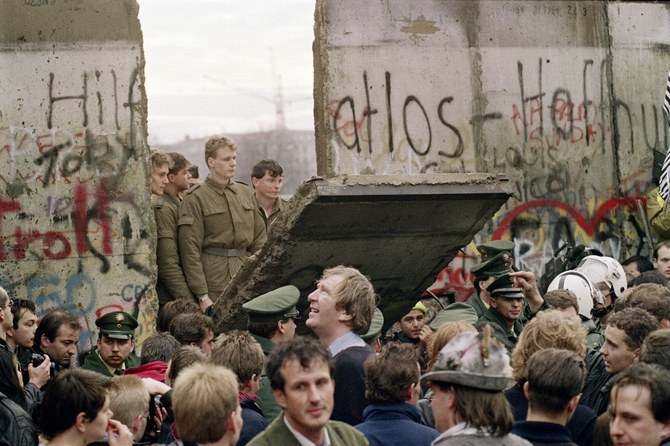
- ARAB NEWS
- 09 Jul 2025

Nov. 9 is an important day in German history. There is a sad day to commemorate and a happy one.
In 1938, the Nazis organized the “Night of Broken Glass” or “November Pogroms,” where they torched places of worship and businesses of Jewish Germans and burnt books and music scores authored by Jews. Antisemitism is shockingly again on the rise in Germany. Islamophobia is also a big theme.
Nov. 9 is also a positive day signifying the indomitable spirit of people striving for freedom and democracy: Exactly 30 years ago the wall between East and West Germany came down, or rather the Government of the German Democratic Republic (GDR) lifted the restrictions for their citizens and allowed them to travel to the west.
There was quite a build-up to the big day. In May, Hungary — which like the GDR was a member of the Moscow-led Warsaw Pact — took down its border fences to Austria. During the so-called “Pan European Picnic,” Hungary opened its borders to Austria temporarily, which allowed 600 GDR citizens to flee to Austria and then transit by train to the Federal Republic of Germany.
On Sept. 30 of the same year, the then foreign minister of West Germany announced to hundreds of GDR citizens, who had taken refuge in the West German Embassy in Prague, that they were free to come to the republic.
From October, tens of thousands hit the streets of the cities in the GDR demonstrating against the oppressive regime and their inability to travel freely. Thousands were arrested. It started on Oct. 7 in Leipzig when an uncontrollable mass of people left churches after evening prayers to demonstrate for their civil rights.
All of this happened against the backdrop of the events in Tiananmen Square, which took a very different turn.
On Nov. 9, the borders were opened and thousands took advantage to go West. Many in the West also went to the East for a look.
On New Year’s Eve, David Hasselhoff sang “I have been looking for freedom” suspended from a crane over the remnants of the Berlin Wall.
There was euphoria in the streets of the East and the West. However, it took still a good year until the reunification of the two Germanies. On Nov. 9, then Chancellor Helmut Kohl was in Budapest. He did not immediately understand that the events would lead to German reunification. Neither did US President George Bush nor British Prime Minister Margret Thatcher. France’s President Francois Mitterrand even considered a unified Germany a threat to peace and stability in Europe.
Alas the events of that day led to the reunification of a country that had been divided for more than 40 years. So, what happened to Germany since then and what can we learn from the collapse of the East?
After the initial euphoria, unification had considerable economic costs in the east and in the west. The decision to convert the East Mark to the same rate of the West Mark was costly and widely criticized. Comparing the economies between the new Eastern states to the old Western ones, the gap was 57 percent in 1990. Today it still is 25 percent and until recently, taxpayers had to provide a “solidarity contribution” for the economic advancement of the new Eastern states.
To this day Germans, classify themselves as Ossies (those from the East) or Wessies (those from the West). Wessies often feel economically superior and many Ossies feel hard done by. It is not coincidence that the “Alternative fuer Deutschland” finds fertile ground in the new states of the East. Like all populists, they are masters at capitalizing on the segments in the population who feel left out. Neither is it surprising that resentment against refugees is higher in the East.
Many resent that they were apparently not given the same privileges and handouts compared to the refugees who came to Germany after 2015. Those who feel disadvantaged feel that unlike the refugees, they are ethnically Germans. While nothing justifies opinions based on ethnic hatred, this is still a prevalent opinion.
There are the success stories too. Chancellor Angela Merkel is the daughter of an East German pastor and former President Joachim Gauk was an East German pastor himself. Indeed, the protestant clergy in the GDR were stalwarts of sensible and silent opposition to the oppressive regime. Gauk and Merkel hail from that tradition.
Euphoria usually gives way to more sober feelings, and often resentment, when high expectations cannot be met. Merkel noted in a speech commemorating 30 years of the wall’s demise that it may take 50 years until the new and the old states will be economically at par. She has a point, but we should not forget that the peaceful dissolution of the GDR and subsequent reunification is a huge success in itself.
Mitterrand was also proven wrong. The unified Germany is far from a threat to the stability and security of Europe. On the contrary, Germany was an important player ensuring a peaceful transition after the fall of the then Soviet Union and Warsaw Pact. The country is also a force for good on the international scene and in the EU, which matters particularly in light of Brexit.
The big upheavals of history always produce winners and losers. However, all in all we are better off with a democratic and unified Germany.
• Cornelia Meyer is a business consultant, macro-economist and energy expert. Twitter: @MeyerResources